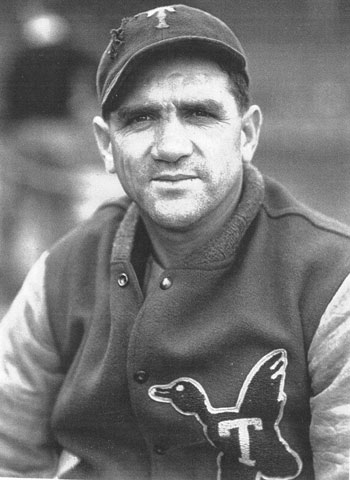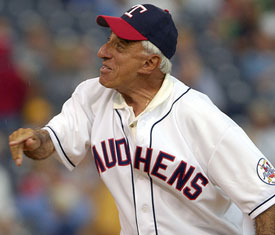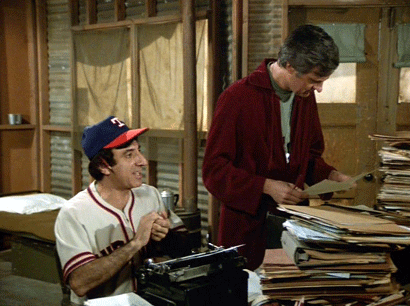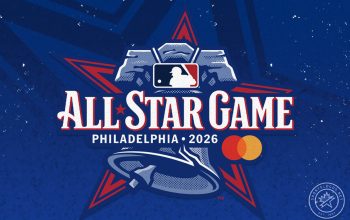The Toledo Mud Hens, triple-A affiliate of the Detroit Tigers, are perhaps the most iconic of all the teams in minor league baseball. If you were going to create a time capsule to tell our distant future descendants about the sport, is there another team you would pick?
The name dates back to 1896, when a gentleman named Charles Strobel purchased the Toledo Swamp Angels midway through the season. “The new owner wanted to play Sunday baseball games, and those were forbidden by blue laws in the city,” said John Husman, the Mud Hens’ team historian and author of the book Baseball in Toledo. “He made arrangements with the street car company to run a line north of the city to an area that’s now called Bay View Park.”
Bay View Park was the natural habitat to the animal that would become one of the most famous namesakes in sports. “The swamp on the edge of the lake was inhabited by what I understand were just literally thousands of American coots, which were commonly known as mud hens,” Husman said.
 And while there are many majestic, beautiful birds in North America, the American coot is not necessarily one of them. “Have you ever seen one?” Husman asked. “Oh, they’re ugly. An ugly black duck. Spindly legs. You ought to look one up. They’re just terrible.”
And while there are many majestic, beautiful birds in North America, the American coot is not necessarily one of them. “Have you ever seen one?” Husman asked. “Oh, they’re ugly. An ugly black duck. Spindly legs. You ought to look one up. They’re just terrible.”
To say that the name has stuck would be an understatement. Toledo has been home to the Mud Hens for more than a century with only a few gaps—the most notable of which was from 1953 to 1955, when the Milwaukee Braves owned the team and called them the Toledo Sox, which was followed by a nine-year period when there was no baseball in Toledo.
When baseball came back in 1965, “there was just no question that it was going to be Mud Hens,” Husman said. “It’s just part of the history of the city and I don’t think people want to let go of that anymore.”
The visual history of the team can be divided into two main eras: pre-Mortimer and post-Mortimer. “We didn’t have a logo that I know of until 1949, and we had the first Mud Hen kind of as we know it,” Husman said. “The Tigers bought the franchise in 1949 and made a lot of changes, and one of them was they developed this logo through a Toledo artist by the name of Robert Parsil.” (The program covers above are from Husman’s collection.)
 The original Mortimer (on the left above) was only around for a few years before the team became the Sox and then went away altogether. When they came back in 1965, Mortimer was redesigned by an artist named Gabe Pinciotti. “He was a spindly legged thing we’ve got now with no pants on,” Husman said (referring to the mascot, not the artist). “That’s been modified a little bit, and now it’s kind of the fierce-looking mud hen.” (Note that the new primary logo at the top of this post is set against the backdrop of an egg.)
The original Mortimer (on the left above) was only around for a few years before the team became the Sox and then went away altogether. When they came back in 1965, Mortimer was redesigned by an artist named Gabe Pinciotti. “He was a spindly legged thing we’ve got now with no pants on,” Husman said (referring to the mascot, not the artist). “That’s been modified a little bit, and now it’s kind of the fierce-looking mud hen.” (Note that the new primary logo at the top of this post is set against the backdrop of an egg.)
While the team’s current mascots are Muddy and Muddonna, in 2012, the Mud Hens introduced a historic Mortimer-based uniform in 2013 to celebrate their team’s visual history.

That said, the cartoon bird might not be the only logo the team has known. Husman provided the above photo from 1933, 34, or 35. “I’ve been on the lookout for this for a long time,” Husman said, “a jacket worn by our manager … that had a different logo that was a mud hen in flight that had a T on it. That’s the only other one I’ve seen prior to 1949.”
Of course, it’s impossible to tell the story of the Toledo Mud Hens without telling the story of Max Klinger, the iconic character played by Toledo native Jamie Farr in the show MASH. When he wasn’t wearing dresses, Klinger famously exposed millions of the show’s fans to the Mud Hens by wearing the team’s gear on the show.

I reached out to Farr, who was gracious and eager to speak about his role in popularizing his hometown’s quirky team, which has been part of his entire life. He grew up watching the Mud Hens through knot holes in the fence at Swayne Field, then many decades later, there he was throwing out the first pitch at a beautiful new stadium—a stadium he helped make a reality by starring in commercials to garner public support for its construction.
The short version of the story of how Max Klinger became the Toledo Mud Hens’ most famous fan is that Jamie Farr is from Toledo and was a fan of the team, so they made his character a fan of the team, too. Farr told me a much longer version of the story, which went like this: MASH’s legendary producer Larry Gelbart grew up in the Hollywood area, and his father Harry was a barber in Beverly Hills—”he was the barber for all the comedians,” Farr said. Harry the barber convinced one of these comedians, Danny Thomas, a Toledo native, to buy jokes from Larry, at the time an aspiring writer. When Larry became a producer on the mega-hit MASH, he saw an opportunity.
“To make Klinger from Toledo was sort of a payback from Larry Gelbart to Danny Thomas for buying his first jokes,” Farr said.
Two of the show’s writers, the legendary David Isaacs and Ken Levine, were also fans of minor league baseball, and played up this part of Klinger’s character. “They thought about this character that Larry Gelbart created, this bizarre character Klinger. What team naturally would this character like but a team called the Mud Hens coming from Toledo, Ohio?” Farr said. “It brought in a team that, first of all, was very unusual in name,” he said. “Mud Hens is just a strange, strange name.”
 Of course, the team loved this exposure, and Gene Cook, the Mud Hens general manager from 1978 to 1998, wanted to make the most of it—which raised a challenge in the show’s efforts to be historically accurate to the period of the Korean War.
Of course, the team loved this exposure, and Gene Cook, the Mud Hens general manager from 1978 to 1998, wanted to make the most of it—which raised a challenge in the show’s efforts to be historically accurate to the period of the Korean War.
“Once the Mud Hens people found out what we were doing, they were sending us stuff,” Farr said. “We wanted to make sure that we had things that were reminiscent of the 50s, although our show obviously was being done in the 70s. The logos changed.”
This raised a couple challenges for Farr. First, he needed to be sure that he was wearing the appropriate team’s gear (“A lot of people when they first saw me wearing that thought it was a Texas Ranger cap that I had on,” he said) and he needed to keep the peace on set.
“Loretta Switt [Hot Lips Houlihan] used to get mad at me because I had better outfits than she did,” he said. “Klinger brought color into the camp because everybody had to wear their olive drab things, with the exception of Alan Alda’s purple robe. Klinger would wear these outrageous outfits and then also bring in Mud Hen caps and shirts and all kinds of stuff. It would just change the whole atmosphere of the camp.”
The show, still in syndication worldwide, draws global attention to the team and helps keep the Mud Hens in the annual list of minor league baseball’s best merchandise sales—once fans of the show realize the team is a real thing. “They thought it was a mythical team until they did some research and found, oh, there really is a Mud Hens team,” Farr said. “Then they started ordering things from them. I’ll be places around the world and somebody will come up to me and say, ‘Hey, Mud Hens!’”
Farr does not get paid for of his involvement with the team—at least in cash— but that’s not to say he doesn’t benefit. “I don’t think I’ve ever paid for a ticket since I was a kid,” he said. “I get in free and they give me free pizza and popcorn and hot dogs and things.”
Of course, photos of Farr are all over the stadium, and his likeness shows up other ways, too. The team once gave away a series of three Jamie Farr bobbleheads to fans. They sent the first two in the series to Farr, but there’s a gaping hole on the mantle where the third one should be. Before we hung up in our conversation, Farr laughingly said to me, “If you can pull any strings, see if you can get me my final bobblehead.”
The Mud Hens have had some of everything a minor league team needs to achieve success—a quirky name with a local connection, longevity in a brand, a loyal fan base, and a stroke of absolute dumb luck. Their brand was already positioned for success by the time MASH came around, but suddenly finding themselves on full display in a TV show that averaged 17 to 20 million viewers thrust them into stardom. They rode that wave masterfully, and now a team that was named for ugly swamp birds in the late 1800s finds itself as the most iconic in the minors.
The Mud Hens are right to treat Jamie Farr like a hero when he comes to town, putting his photo up all over the stadium and lavishing him and his guests with tickets and concessions. But still, who knows where they’d be without him, so the least they can do is get that last bobblehead to him, right?

















